Quick filters:
Beet yellow virus Stock Photos and Images
 Sugar beet virus yellows (SBVY) chlorosis and necrosis on leaves of a sugar beet plant in a mature crop, Cambridgeshire Stock Photohttps://www.alamy.com/image-license-details/?v=1https://www.alamy.com/sugar-beet-virus-yellows-sbvy-chlorosis-and-necrosis-on-leaves-of-a-sugar-beet-plant-in-a-mature-crop-cambridgeshire-image345020855.html
Sugar beet virus yellows (SBVY) chlorosis and necrosis on leaves of a sugar beet plant in a mature crop, Cambridgeshire Stock Photohttps://www.alamy.com/image-license-details/?v=1https://www.alamy.com/sugar-beet-virus-yellows-sbvy-chlorosis-and-necrosis-on-leaves-of-a-sugar-beet-plant-in-a-mature-crop-cambridgeshire-image345020855.htmlRM2B191HB–Sugar beet virus yellows (SBVY) chlorosis and necrosis on leaves of a sugar beet plant in a mature crop, Cambridgeshire
 Beet Necrotic Yellow Virus Stock Photohttps://www.alamy.com/image-license-details/?v=1https://www.alamy.com/stock-photo-beet-necrotic-yellow-virus-134943895.html
Beet Necrotic Yellow Virus Stock Photohttps://www.alamy.com/image-license-details/?v=1https://www.alamy.com/stock-photo-beet-necrotic-yellow-virus-134943895.htmlRMHRF68R–Beet Necrotic Yellow Virus
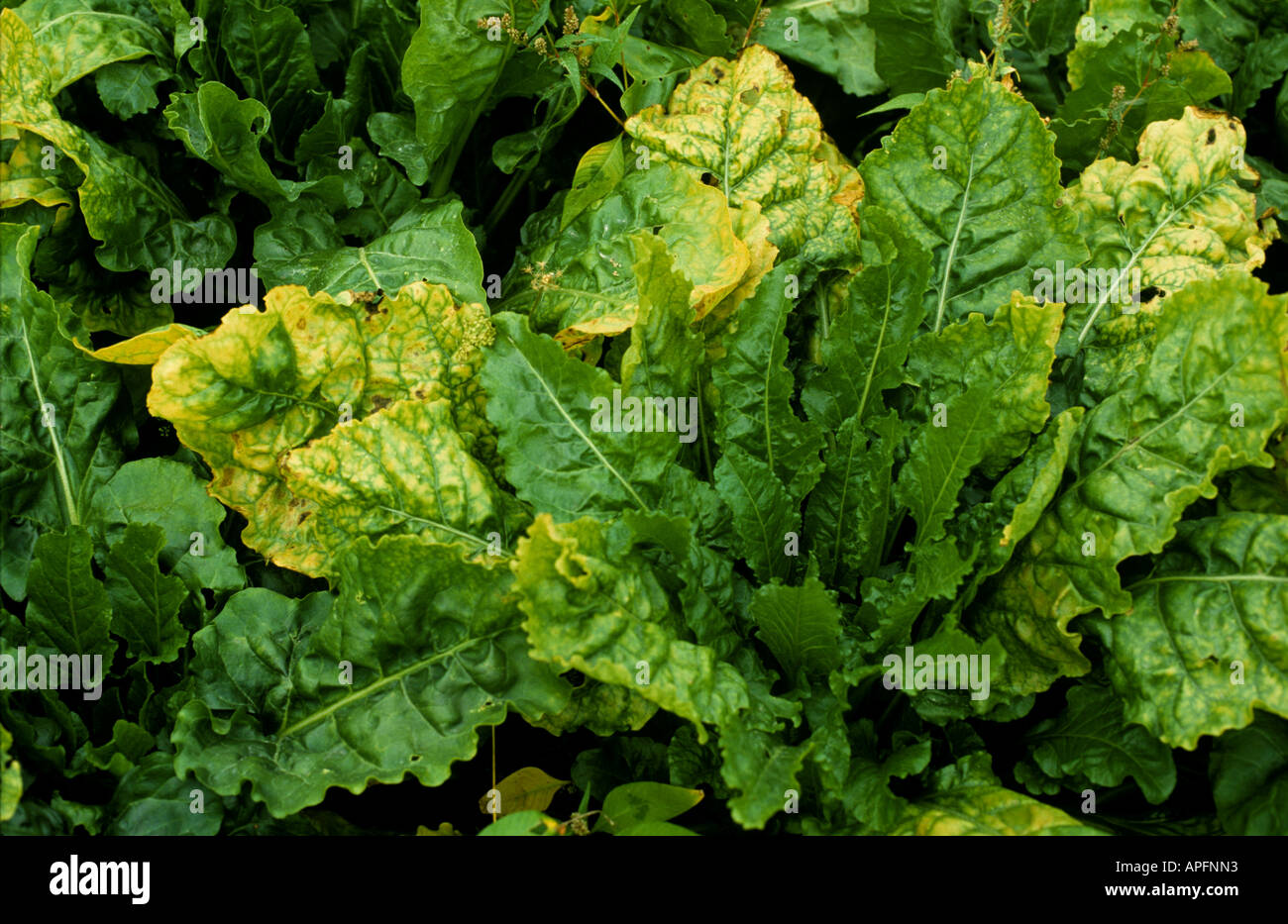 Sugar beet virus yellows SBVY infection on mature sugar beet plant Stock Photohttps://www.alamy.com/image-license-details/?v=1https://www.alamy.com/sugar-beet-virus-yellows-sbvy-infection-on-mature-sugar-beet-plant-image9016082.html
Sugar beet virus yellows SBVY infection on mature sugar beet plant Stock Photohttps://www.alamy.com/image-license-details/?v=1https://www.alamy.com/sugar-beet-virus-yellows-sbvy-infection-on-mature-sugar-beet-plant-image9016082.htmlRMAPFNN3–Sugar beet virus yellows SBVY infection on mature sugar beet plant
 Fresh foods to strengthen the immune system to fight the Corona Virus 2019, COVID 19 Stock Photohttps://www.alamy.com/image-license-details/?v=1https://www.alamy.com/fresh-foods-to-strengthen-the-immune-system-to-fight-the-corona-virus-2019-covid-19-image353286966.html
Fresh foods to strengthen the immune system to fight the Corona Virus 2019, COVID 19 Stock Photohttps://www.alamy.com/image-license-details/?v=1https://www.alamy.com/fresh-foods-to-strengthen-the-immune-system-to-fight-the-corona-virus-2019-covid-19-image353286966.htmlRF2BENH3J–Fresh foods to strengthen the immune system to fight the Corona Virus 2019, COVID 19
 Sugar beet virus yellows SBVY infection on mature sugar beet plant Stock Photohttps://www.alamy.com/image-license-details/?v=1https://www.alamy.com/sugar-beet-virus-yellows-sbvy-infection-on-mature-sugar-beet-plant-image9015462.html
Sugar beet virus yellows SBVY infection on mature sugar beet plant Stock Photohttps://www.alamy.com/image-license-details/?v=1https://www.alamy.com/sugar-beet-virus-yellows-sbvy-infection-on-mature-sugar-beet-plant-image9015462.htmlRMAPFJJ7–Sugar beet virus yellows SBVY infection on mature sugar beet plant
 Beet fields are yellow. Last spring, the plant fell victim to an aphid that transmitted the yellowing virus, blocking photosynthesis. The result: leaves that lose their greenness, beets that do not grow, and a lower sugar content than usual. On September 11, 2020 in Saint-Just-en-Brie, France. (Photo by Emeric Fohlen/NurPhoto) Stock Photohttps://www.alamy.com/image-license-details/?v=1https://www.alamy.com/beet-fields-are-yellow-last-spring-the-plant-fell-victim-to-an-aphid-that-transmitted-the-yellowing-virus-blocking-photosynthesis-the-result-leaves-that-lose-their-greenness-beets-that-do-not-grow-and-a-lower-sugar-content-than-usual-on-september-11-2020-in-saint-just-en-brie-france-photo-by-emeric-fohlennurphoto-image489269815.html
Beet fields are yellow. Last spring, the plant fell victim to an aphid that transmitted the yellowing virus, blocking photosynthesis. The result: leaves that lose their greenness, beets that do not grow, and a lower sugar content than usual. On September 11, 2020 in Saint-Just-en-Brie, France. (Photo by Emeric Fohlen/NurPhoto) Stock Photohttps://www.alamy.com/image-license-details/?v=1https://www.alamy.com/beet-fields-are-yellow-last-spring-the-plant-fell-victim-to-an-aphid-that-transmitted-the-yellowing-virus-blocking-photosynthesis-the-result-leaves-that-lose-their-greenness-beets-that-do-not-grow-and-a-lower-sugar-content-than-usual-on-september-11-2020-in-saint-just-en-brie-france-photo-by-emeric-fohlennurphoto-image489269815.htmlRM2KC04HY–Beet fields are yellow. Last spring, the plant fell victim to an aphid that transmitted the yellowing virus, blocking photosynthesis. The result: leaves that lose their greenness, beets that do not grow, and a lower sugar content than usual. On September 11, 2020 in Saint-Just-en-Brie, France. (Photo by Emeric Fohlen/NurPhoto)
 Beet necrotic yellow vein virus or rhizomania on sugar beet plant Stock Photohttps://www.alamy.com/image-license-details/?v=1https://www.alamy.com/beet-necrotic-yellow-vein-virus-or-rhizomania-on-sugar-beet-plant-image6641687.html
Beet necrotic yellow vein virus or rhizomania on sugar beet plant Stock Photohttps://www.alamy.com/image-license-details/?v=1https://www.alamy.com/beet-necrotic-yellow-vein-virus-or-rhizomania-on-sugar-beet-plant-image6641687.htmlRMA6P2W8–Beet necrotic yellow vein virus or rhizomania on sugar beet plant
 Tulips (Tulipa) form a genus of spring-blooming perennial herbaceous bulbiferous geophytes. The flowers are usually large, showy and brightly coloured. Stock Photohttps://www.alamy.com/image-license-details/?v=1https://www.alamy.com/tulips-tulipa-form-a-genus-of-spring-blooming-perennial-herbaceous-bulbiferous-geophytes-the-flowers-are-usually-large-showy-and-brightly-coloured-image214178042.html
Tulips (Tulipa) form a genus of spring-blooming perennial herbaceous bulbiferous geophytes. The flowers are usually large, showy and brightly coloured. Stock Photohttps://www.alamy.com/image-license-details/?v=1https://www.alamy.com/tulips-tulipa-form-a-genus-of-spring-blooming-perennial-herbaceous-bulbiferous-geophytes-the-flowers-are-usually-large-showy-and-brightly-coloured-image214178042.htmlRFPCCJ7P–Tulips (Tulipa) form a genus of spring-blooming perennial herbaceous bulbiferous geophytes. The flowers are usually large, showy and brightly coloured.
 Necrotic yellow vein virus or rhizomania sugar beet root section showing damage Stock Photohttps://www.alamy.com/image-license-details/?v=1https://www.alamy.com/necrotic-yellow-vein-virus-or-rhizomania-sugar-beet-root-section-showing-image9015483.html
Necrotic yellow vein virus or rhizomania sugar beet root section showing damage Stock Photohttps://www.alamy.com/image-license-details/?v=1https://www.alamy.com/necrotic-yellow-vein-virus-or-rhizomania-sugar-beet-root-section-showing-image9015483.htmlRMAPFJKC–Necrotic yellow vein virus or rhizomania sugar beet root section showing damage
 . Fig. 21.—Young beet plant affected with curly top. Many other kinds of plants are also susceptible, the most important being the tomato, in which the disease was first called "western yellow blight." For other hosts, see the general discussion of this disease (p. 68). Curly top is an extremely sporadic disease, being evy abundant and destructive some years and again almost absent. The cause of the disease is a virus. As a rule it is more common in the warmer interior valleys and Stock Photohttps://www.alamy.com/image-license-details/?v=1https://www.alamy.com/fig-21young-beet-plant-affected-with-curly-top-many-other-kinds-of-plants-are-also-susceptible-the-most-important-being-the-tomato-in-which-the-disease-was-first-called-quotwestern-yellow-blightquot-for-other-hosts-see-the-general-discussion-of-this-disease-p-68-curly-top-is-an-extremely-sporadic-disease-being-evy-abundant-and-destructive-some-years-and-again-almost-absent-the-cause-of-the-disease-is-a-virus-as-a-rule-it-is-more-common-in-the-warmer-interior-valleys-and-image179904250.html
. Fig. 21.—Young beet plant affected with curly top. Many other kinds of plants are also susceptible, the most important being the tomato, in which the disease was first called "western yellow blight." For other hosts, see the general discussion of this disease (p. 68). Curly top is an extremely sporadic disease, being evy abundant and destructive some years and again almost absent. The cause of the disease is a virus. As a rule it is more common in the warmer interior valleys and Stock Photohttps://www.alamy.com/image-license-details/?v=1https://www.alamy.com/fig-21young-beet-plant-affected-with-curly-top-many-other-kinds-of-plants-are-also-susceptible-the-most-important-being-the-tomato-in-which-the-disease-was-first-called-quotwestern-yellow-blightquot-for-other-hosts-see-the-general-discussion-of-this-disease-p-68-curly-top-is-an-extremely-sporadic-disease-being-evy-abundant-and-destructive-some-years-and-again-almost-absent-the-cause-of-the-disease-is-a-virus-as-a-rule-it-is-more-common-in-the-warmer-interior-valleys-and-image179904250.htmlRMMCK9KP–. Fig. 21.—Young beet plant affected with curly top. Many other kinds of plants are also susceptible, the most important being the tomato, in which the disease was first called "western yellow blight." For other hosts, see the general discussion of this disease (p. 68). Curly top is an extremely sporadic disease, being evy abundant and destructive some years and again almost absent. The cause of the disease is a virus. As a rule it is more common in the warmer interior valleys and
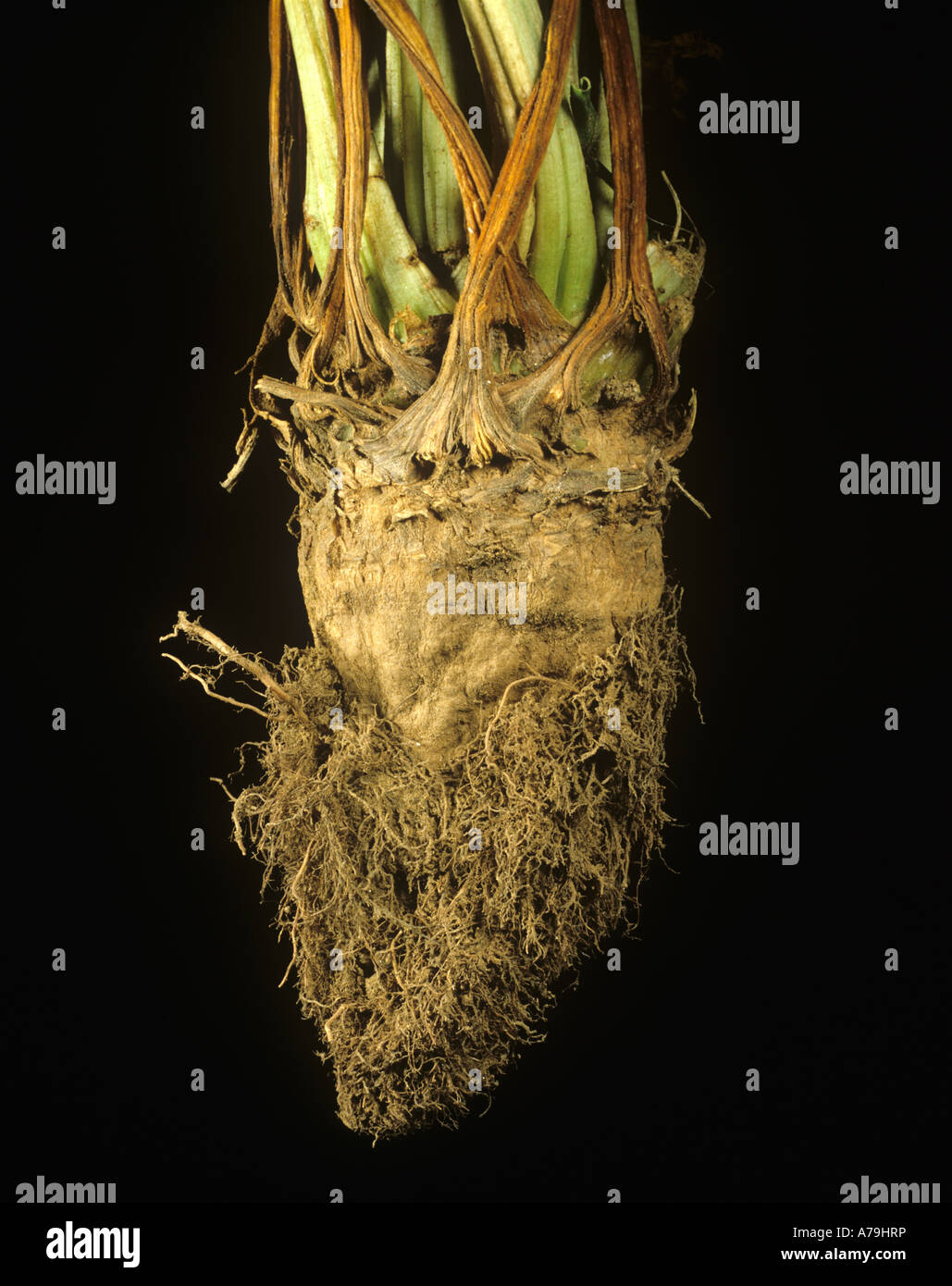 Necrotic yellow vein virus or rhizomania random adventitious root growth on a sugar beet root Stock Photohttps://www.alamy.com/image-license-details/?v=1https://www.alamy.com/stock-photo-necrotic-yellow-vein-virus-or-rhizomania-random-adventitious-root-11769129.html
Necrotic yellow vein virus or rhizomania random adventitious root growth on a sugar beet root Stock Photohttps://www.alamy.com/image-license-details/?v=1https://www.alamy.com/stock-photo-necrotic-yellow-vein-virus-or-rhizomania-random-adventitious-root-11769129.htmlRMA79HRP–Necrotic yellow vein virus or rhizomania random adventitious root growth on a sugar beet root
 . Diseases of truck crops / Ralph E. Smith. Plant diseases; Plant parasites; Vegetables; Agricultural pests. Diseases of Truck Crops 83 lets curl inward and become crisp, yellow, and thickened (fig. 37). This is the same disease as curly top of sugar beets: it is caused by the same virus and is also spread by the beet leafhopper, Eutettix tencllus. It is most prevalent in the southern interior valleys of the state and some years wipes out entire crops of tomatoes. Tomatoes should not be planted where the hazard of this disease is. Fig. 37.—Tomato curly top. (From Ext. Cir. 66.) too great. No g Stock Photohttps://www.alamy.com/image-license-details/?v=1https://www.alamy.com/diseases-of-truck-crops-ralph-e-smith-plant-diseases-plant-parasites-vegetables-agricultural-pests-diseases-of-truck-crops-83-lets-curl-inward-and-become-crisp-yellow-and-thickened-fig-37-this-is-the-same-disease-as-curly-top-of-sugar-beets-it-is-caused-by-the-same-virus-and-is-also-spread-by-the-beet-leafhopper-eutettix-tencllus-it-is-most-prevalent-in-the-southern-interior-valleys-of-the-state-and-some-years-wipes-out-entire-crops-of-tomatoes-tomatoes-should-not-be-planted-where-the-hazard-of-this-disease-is-fig-37tomato-curly-top-from-ext-cir-66-too-great-no-g-image231389172.html
. Diseases of truck crops / Ralph E. Smith. Plant diseases; Plant parasites; Vegetables; Agricultural pests. Diseases of Truck Crops 83 lets curl inward and become crisp, yellow, and thickened (fig. 37). This is the same disease as curly top of sugar beets: it is caused by the same virus and is also spread by the beet leafhopper, Eutettix tencllus. It is most prevalent in the southern interior valleys of the state and some years wipes out entire crops of tomatoes. Tomatoes should not be planted where the hazard of this disease is. Fig. 37.—Tomato curly top. (From Ext. Cir. 66.) too great. No g Stock Photohttps://www.alamy.com/image-license-details/?v=1https://www.alamy.com/diseases-of-truck-crops-ralph-e-smith-plant-diseases-plant-parasites-vegetables-agricultural-pests-diseases-of-truck-crops-83-lets-curl-inward-and-become-crisp-yellow-and-thickened-fig-37-this-is-the-same-disease-as-curly-top-of-sugar-beets-it-is-caused-by-the-same-virus-and-is-also-spread-by-the-beet-leafhopper-eutettix-tencllus-it-is-most-prevalent-in-the-southern-interior-valleys-of-the-state-and-some-years-wipes-out-entire-crops-of-tomatoes-tomatoes-should-not-be-planted-where-the-hazard-of-this-disease-is-fig-37tomato-curly-top-from-ext-cir-66-too-great-no-g-image231389172.htmlRMRCCK70–. Diseases of truck crops / Ralph E. Smith. Plant diseases; Plant parasites; Vegetables; Agricultural pests. Diseases of Truck Crops 83 lets curl inward and become crisp, yellow, and thickened (fig. 37). This is the same disease as curly top of sugar beets: it is caused by the same virus and is also spread by the beet leafhopper, Eutettix tencllus. It is most prevalent in the southern interior valleys of the state and some years wipes out entire crops of tomatoes. Tomatoes should not be planted where the hazard of this disease is. Fig. 37.—Tomato curly top. (From Ext. Cir. 66.) too great. No g
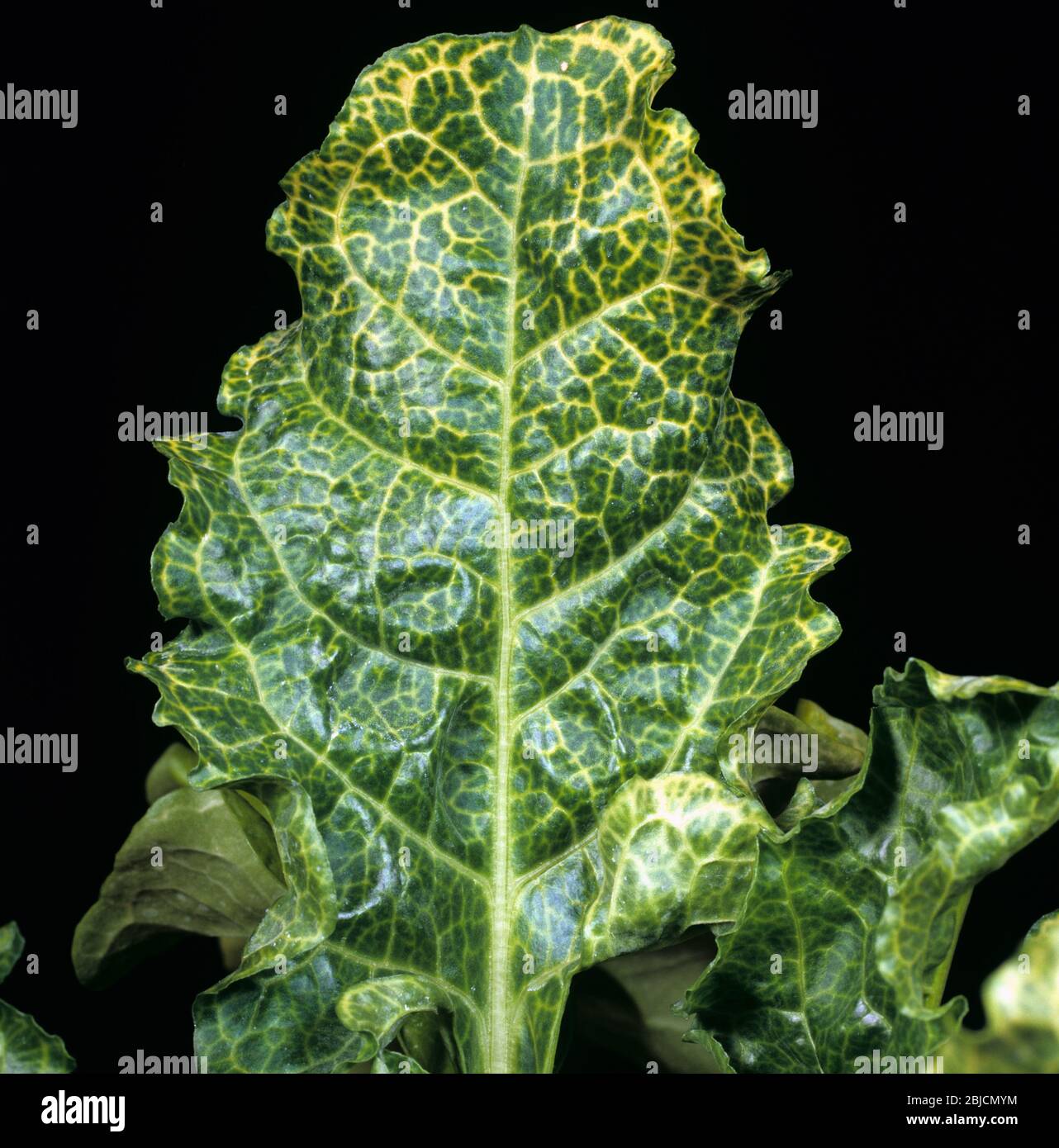 Beet necrotic yellow vein virus (BNYVV) or rhizomania mosaic symptoms on sugar beet leaves, Greece Stock Photohttps://www.alamy.com/image-license-details/?v=1https://www.alamy.com/beet-necrotic-yellow-vein-virus-bnyvv-or-rhizomania-mosaic-symptoms-on-sugar-beet-leaves-greece-image355551048.html
Beet necrotic yellow vein virus (BNYVV) or rhizomania mosaic symptoms on sugar beet leaves, Greece Stock Photohttps://www.alamy.com/image-license-details/?v=1https://www.alamy.com/beet-necrotic-yellow-vein-virus-bnyvv-or-rhizomania-mosaic-symptoms-on-sugar-beet-leaves-greece-image355551048.htmlRM2BJCMYM–Beet necrotic yellow vein virus (BNYVV) or rhizomania mosaic symptoms on sugar beet leaves, Greece
 Rhizomania symptom of hairy secondary root development caused by beet necrotic yellow vein virus (BNYVV) to sugar beet, Greece Stock Photohttps://www.alamy.com/image-license-details/?v=1https://www.alamy.com/rhizomania-symptom-of-hairy-secondary-root-development-caused-by-beet-necrotic-yellow-vein-virus-bnyvv-to-sugar-beet-greece-image393349100.html
Rhizomania symptom of hairy secondary root development caused by beet necrotic yellow vein virus (BNYVV) to sugar beet, Greece Stock Photohttps://www.alamy.com/image-license-details/?v=1https://www.alamy.com/rhizomania-symptom-of-hairy-secondary-root-development-caused-by-beet-necrotic-yellow-vein-virus-bnyvv-to-sugar-beet-greece-image393349100.htmlRM2DRXGP4–Rhizomania symptom of hairy secondary root development caused by beet necrotic yellow vein virus (BNYVV) to sugar beet, Greece
 Beet Necrotic Yellow Virus, TEM Stock Photohttps://www.alamy.com/image-license-details/?v=1https://www.alamy.com/stock-photo-beet-necrotic-yellow-virus-tem-135012370.html
Beet Necrotic Yellow Virus, TEM Stock Photohttps://www.alamy.com/image-license-details/?v=1https://www.alamy.com/stock-photo-beet-necrotic-yellow-virus-tem-135012370.htmlRMHRJ9JA–Beet Necrotic Yellow Virus, TEM
 Fresh foods to strengthen the immune system to fight the Corona Virus 2019, COVID 19 Stock Photohttps://www.alamy.com/image-license-details/?v=1https://www.alamy.com/fresh-foods-to-strengthen-the-immune-system-to-fight-the-corona-virus-2019-covid-19-image353286973.html
Fresh foods to strengthen the immune system to fight the Corona Virus 2019, COVID 19 Stock Photohttps://www.alamy.com/image-license-details/?v=1https://www.alamy.com/fresh-foods-to-strengthen-the-immune-system-to-fight-the-corona-virus-2019-covid-19-image353286973.htmlRF2BENH3W–Fresh foods to strengthen the immune system to fight the Corona Virus 2019, COVID 19
 Beet fields are yellow. Last spring, the plant fell victim to an aphid that transmitted the yellowing virus, blocking photosynthesis. The result: leaves that lose their greenness, beets that do not grow, and a lower sugar content than usual. On September 11, 2020 in Saint-Just-en-Brie, France. (Photo by Emeric Fohlen/NurPhoto) Stock Photohttps://www.alamy.com/image-license-details/?v=1https://www.alamy.com/beet-fields-are-yellow-last-spring-the-plant-fell-victim-to-an-aphid-that-transmitted-the-yellowing-virus-blocking-photosynthesis-the-result-leaves-that-lose-their-greenness-beets-that-do-not-grow-and-a-lower-sugar-content-than-usual-on-september-11-2020-in-saint-just-en-brie-france-photo-by-emeric-fohlennurphoto-image489269791.html
Beet fields are yellow. Last spring, the plant fell victim to an aphid that transmitted the yellowing virus, blocking photosynthesis. The result: leaves that lose their greenness, beets that do not grow, and a lower sugar content than usual. On September 11, 2020 in Saint-Just-en-Brie, France. (Photo by Emeric Fohlen/NurPhoto) Stock Photohttps://www.alamy.com/image-license-details/?v=1https://www.alamy.com/beet-fields-are-yellow-last-spring-the-plant-fell-victim-to-an-aphid-that-transmitted-the-yellowing-virus-blocking-photosynthesis-the-result-leaves-that-lose-their-greenness-beets-that-do-not-grow-and-a-lower-sugar-content-than-usual-on-september-11-2020-in-saint-just-en-brie-france-photo-by-emeric-fohlennurphoto-image489269791.htmlRM2KC04H3–Beet fields are yellow. Last spring, the plant fell victim to an aphid that transmitted the yellowing virus, blocking photosynthesis. The result: leaves that lose their greenness, beets that do not grow, and a lower sugar content than usual. On September 11, 2020 in Saint-Just-en-Brie, France. (Photo by Emeric Fohlen/NurPhoto)
 Tulips (Tulipa) form a genus of spring-blooming perennial herbaceous bulbiferous geophytes. The flowers are usually large, showy and brightly coloured Stock Photohttps://www.alamy.com/image-license-details/?v=1https://www.alamy.com/tulips-tulipa-form-a-genus-of-spring-blooming-perennial-herbaceous-bulbiferous-geophytes-the-flowers-are-usually-large-showy-and-brightly-coloured-image214335520.html
Tulips (Tulipa) form a genus of spring-blooming perennial herbaceous bulbiferous geophytes. The flowers are usually large, showy and brightly coloured Stock Photohttps://www.alamy.com/image-license-details/?v=1https://www.alamy.com/tulips-tulipa-form-a-genus-of-spring-blooming-perennial-herbaceous-bulbiferous-geophytes-the-flowers-are-usually-large-showy-and-brightly-coloured-image214335520.htmlRFPCKR40–Tulips (Tulipa) form a genus of spring-blooming perennial herbaceous bulbiferous geophytes. The flowers are usually large, showy and brightly coloured
 Rhizomania symptom of hairy secondary root development and necrosis caused by beet necrotic yellow vein virus (BNYVV) to sugar beet, Greece Stock Photohttps://www.alamy.com/image-license-details/?v=1https://www.alamy.com/rhizomania-symptom-of-hairy-secondary-root-development-and-necrosis-caused-by-beet-necrotic-yellow-vein-virus-bnyvv-to-sugar-beet-greece-image393349289.html
Rhizomania symptom of hairy secondary root development and necrosis caused by beet necrotic yellow vein virus (BNYVV) to sugar beet, Greece Stock Photohttps://www.alamy.com/image-license-details/?v=1https://www.alamy.com/rhizomania-symptom-of-hairy-secondary-root-development-and-necrosis-caused-by-beet-necrotic-yellow-vein-virus-bnyvv-to-sugar-beet-greece-image393349289.htmlRM2DRXH0W–Rhizomania symptom of hairy secondary root development and necrosis caused by beet necrotic yellow vein virus (BNYVV) to sugar beet, Greece
 Beet Necrotic Yellow Virus, TEM Stock Photohttps://www.alamy.com/image-license-details/?v=1https://www.alamy.com/stock-photo-beet-necrotic-yellow-virus-tem-135012371.html
Beet Necrotic Yellow Virus, TEM Stock Photohttps://www.alamy.com/image-license-details/?v=1https://www.alamy.com/stock-photo-beet-necrotic-yellow-virus-tem-135012371.htmlRMHRJ9JB–Beet Necrotic Yellow Virus, TEM
 Fresh foods to strengthen the immune system to fight the Corona Virus 2019, COVID 19 Stock Photohttps://www.alamy.com/image-license-details/?v=1https://www.alamy.com/fresh-foods-to-strengthen-the-immune-system-to-fight-the-corona-virus-2019-covid-19-image353286968.html
Fresh foods to strengthen the immune system to fight the Corona Virus 2019, COVID 19 Stock Photohttps://www.alamy.com/image-license-details/?v=1https://www.alamy.com/fresh-foods-to-strengthen-the-immune-system-to-fight-the-corona-virus-2019-covid-19-image353286968.htmlRF2BENH3M–Fresh foods to strengthen the immune system to fight the Corona Virus 2019, COVID 19
 A beet plant contaminated by yellowing. Last spring, the plant fell victim to an aphid that transmitted the yellowing virus, blocking photosynthesis. The result: leaves that lose their greenness, beets that do not grow, and a lower sugar content than usual. This unprecedented crisis is threatening the beet industry. On September 11, 2020 in Saint-Just-en-Brie, France. (Photo by Emeric Fohlen/NurPhoto) Stock Photohttps://www.alamy.com/image-license-details/?v=1https://www.alamy.com/a-beet-plant-contaminated-by-yellowing-last-spring-the-plant-fell-victim-to-an-aphid-that-transmitted-the-yellowing-virus-blocking-photosynthesis-the-result-leaves-that-lose-their-greenness-beets-that-do-not-grow-and-a-lower-sugar-content-than-usual-this-unprecedented-crisis-is-threatening-the-beet-industry-on-september-11-2020-in-saint-just-en-brie-france-photo-by-emeric-fohlennurphoto-image489269801.html
A beet plant contaminated by yellowing. Last spring, the plant fell victim to an aphid that transmitted the yellowing virus, blocking photosynthesis. The result: leaves that lose their greenness, beets that do not grow, and a lower sugar content than usual. This unprecedented crisis is threatening the beet industry. On September 11, 2020 in Saint-Just-en-Brie, France. (Photo by Emeric Fohlen/NurPhoto) Stock Photohttps://www.alamy.com/image-license-details/?v=1https://www.alamy.com/a-beet-plant-contaminated-by-yellowing-last-spring-the-plant-fell-victim-to-an-aphid-that-transmitted-the-yellowing-virus-blocking-photosynthesis-the-result-leaves-that-lose-their-greenness-beets-that-do-not-grow-and-a-lower-sugar-content-than-usual-this-unprecedented-crisis-is-threatening-the-beet-industry-on-september-11-2020-in-saint-just-en-brie-france-photo-by-emeric-fohlennurphoto-image489269801.htmlRM2KC04HD–A beet plant contaminated by yellowing. Last spring, the plant fell victim to an aphid that transmitted the yellowing virus, blocking photosynthesis. The result: leaves that lose their greenness, beets that do not grow, and a lower sugar content than usual. This unprecedented crisis is threatening the beet industry. On September 11, 2020 in Saint-Just-en-Brie, France. (Photo by Emeric Fohlen/NurPhoto)
 Tulips (Tulipa) form a genus of spring-blooming perennial herbaceous bulbiferous geophytes. The flowers are usually large, showy and brightly coloured. Stock Photohttps://www.alamy.com/image-license-details/?v=1https://www.alamy.com/tulips-tulipa-form-a-genus-of-spring-blooming-perennial-herbaceous-bulbiferous-geophytes-the-flowers-are-usually-large-showy-and-brightly-coloured-image214178077.html
Tulips (Tulipa) form a genus of spring-blooming perennial herbaceous bulbiferous geophytes. The flowers are usually large, showy and brightly coloured. Stock Photohttps://www.alamy.com/image-license-details/?v=1https://www.alamy.com/tulips-tulipa-form-a-genus-of-spring-blooming-perennial-herbaceous-bulbiferous-geophytes-the-flowers-are-usually-large-showy-and-brightly-coloured-image214178077.htmlRFPCCJ91–Tulips (Tulipa) form a genus of spring-blooming perennial herbaceous bulbiferous geophytes. The flowers are usually large, showy and brightly coloured.
 Rhizomania symptom of hairy secondary root development and distortion caused by beet necrotic yellow vein virus (BNYVV) to sugar beet, Greece Stock Photohttps://www.alamy.com/image-license-details/?v=1https://www.alamy.com/rhizomania-symptom-of-hairy-secondary-root-development-and-distortion-caused-by-beet-necrotic-yellow-vein-virus-bnyvv-to-sugar-beet-greece-image393349143.html
Rhizomania symptom of hairy secondary root development and distortion caused by beet necrotic yellow vein virus (BNYVV) to sugar beet, Greece Stock Photohttps://www.alamy.com/image-license-details/?v=1https://www.alamy.com/rhizomania-symptom-of-hairy-secondary-root-development-and-distortion-caused-by-beet-necrotic-yellow-vein-virus-bnyvv-to-sugar-beet-greece-image393349143.htmlRM2DRXGRK–Rhizomania symptom of hairy secondary root development and distortion caused by beet necrotic yellow vein virus (BNYVV) to sugar beet, Greece
 Beet Necrotic Yellow Virus, TEM Stock Photohttps://www.alamy.com/image-license-details/?v=1https://www.alamy.com/stock-photo-beet-necrotic-yellow-virus-tem-135012372.html
Beet Necrotic Yellow Virus, TEM Stock Photohttps://www.alamy.com/image-license-details/?v=1https://www.alamy.com/stock-photo-beet-necrotic-yellow-virus-tem-135012372.htmlRMHRJ9JC–Beet Necrotic Yellow Virus, TEM
 Fresh foods to strengthen the immune system to fight the Corona Virus 2019, COVID 19 Stock Photohttps://www.alamy.com/image-license-details/?v=1https://www.alamy.com/fresh-foods-to-strengthen-the-immune-system-to-fight-the-corona-virus-2019-covid-19-image353286972.html
Fresh foods to strengthen the immune system to fight the Corona Virus 2019, COVID 19 Stock Photohttps://www.alamy.com/image-license-details/?v=1https://www.alamy.com/fresh-foods-to-strengthen-the-immune-system-to-fight-the-corona-virus-2019-covid-19-image353286972.htmlRF2BENH3T–Fresh foods to strengthen the immune system to fight the Corona Virus 2019, COVID 19
 A beet plant contaminated by yellowing. Last spring, the plant fell victim to an aphid that transmitted the yellowing virus, blocking photosynthesis. The result: leaves that lose their greenness, beets that do not grow, and a lower sugar content than usual. This unprecedented crisis is threatening the beet industry. On September 11, 2020 in Saint-Just-en-Brie, France. (Photo by Emeric Fohlen/NurPhoto) Stock Photohttps://www.alamy.com/image-license-details/?v=1https://www.alamy.com/a-beet-plant-contaminated-by-yellowing-last-spring-the-plant-fell-victim-to-an-aphid-that-transmitted-the-yellowing-virus-blocking-photosynthesis-the-result-leaves-that-lose-their-greenness-beets-that-do-not-grow-and-a-lower-sugar-content-than-usual-this-unprecedented-crisis-is-threatening-the-beet-industry-on-september-11-2020-in-saint-just-en-brie-france-photo-by-emeric-fohlennurphoto-image489269799.html
A beet plant contaminated by yellowing. Last spring, the plant fell victim to an aphid that transmitted the yellowing virus, blocking photosynthesis. The result: leaves that lose their greenness, beets that do not grow, and a lower sugar content than usual. This unprecedented crisis is threatening the beet industry. On September 11, 2020 in Saint-Just-en-Brie, France. (Photo by Emeric Fohlen/NurPhoto) Stock Photohttps://www.alamy.com/image-license-details/?v=1https://www.alamy.com/a-beet-plant-contaminated-by-yellowing-last-spring-the-plant-fell-victim-to-an-aphid-that-transmitted-the-yellowing-virus-blocking-photosynthesis-the-result-leaves-that-lose-their-greenness-beets-that-do-not-grow-and-a-lower-sugar-content-than-usual-this-unprecedented-crisis-is-threatening-the-beet-industry-on-september-11-2020-in-saint-just-en-brie-france-photo-by-emeric-fohlennurphoto-image489269799.htmlRM2KC04HB–A beet plant contaminated by yellowing. Last spring, the plant fell victim to an aphid that transmitted the yellowing virus, blocking photosynthesis. The result: leaves that lose their greenness, beets that do not grow, and a lower sugar content than usual. This unprecedented crisis is threatening the beet industry. On September 11, 2020 in Saint-Just-en-Brie, France. (Photo by Emeric Fohlen/NurPhoto)
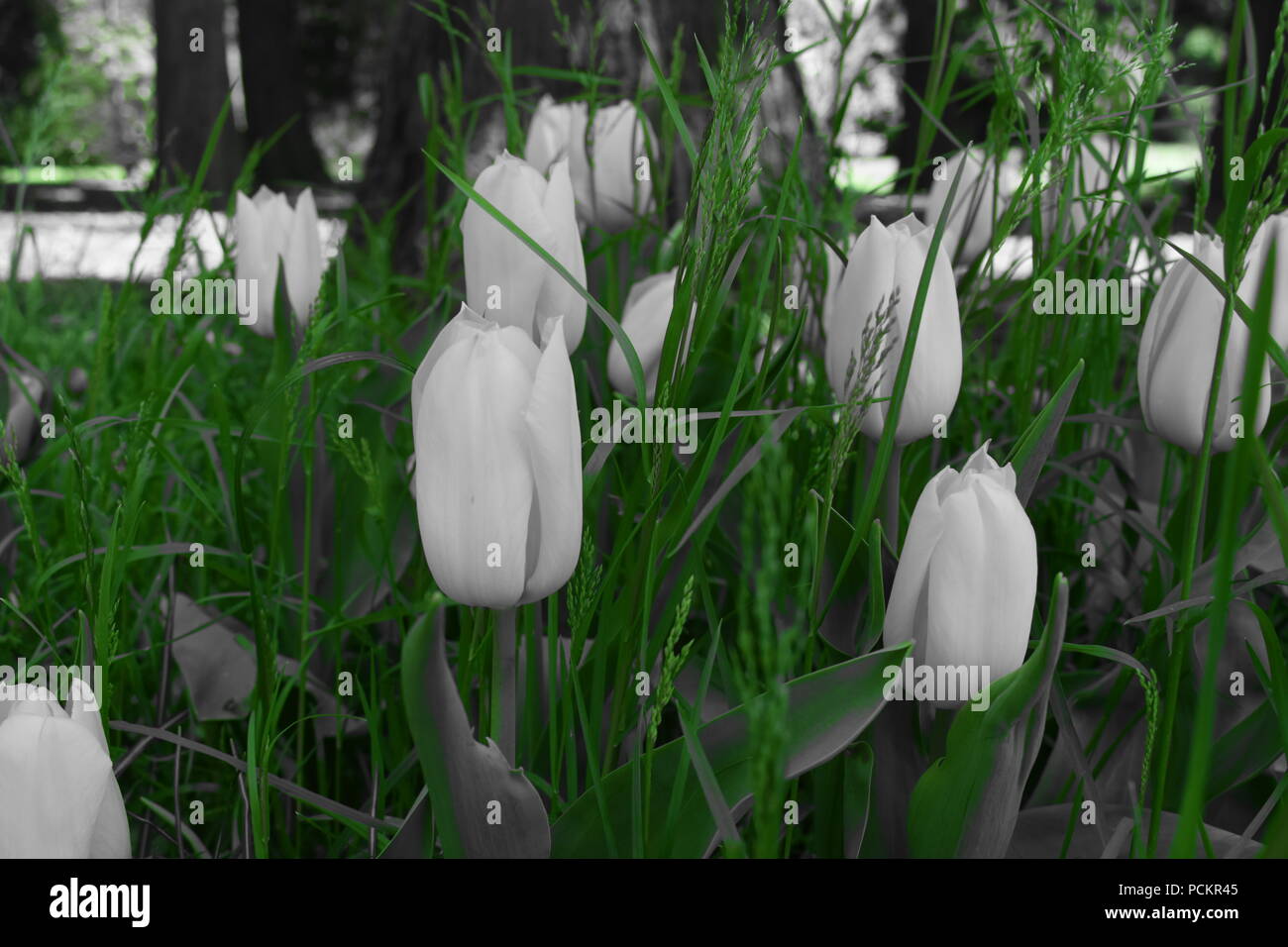 Tulips (Tulipa) form a genus of spring-blooming perennial herbaceous bulbiferous geophytes. The flowers are usually large, showy and brightly coloured Stock Photohttps://www.alamy.com/image-license-details/?v=1https://www.alamy.com/tulips-tulipa-form-a-genus-of-spring-blooming-perennial-herbaceous-bulbiferous-geophytes-the-flowers-are-usually-large-showy-and-brightly-coloured-image214335525.html
Tulips (Tulipa) form a genus of spring-blooming perennial herbaceous bulbiferous geophytes. The flowers are usually large, showy and brightly coloured Stock Photohttps://www.alamy.com/image-license-details/?v=1https://www.alamy.com/tulips-tulipa-form-a-genus-of-spring-blooming-perennial-herbaceous-bulbiferous-geophytes-the-flowers-are-usually-large-showy-and-brightly-coloured-image214335525.htmlRFPCKR45–Tulips (Tulipa) form a genus of spring-blooming perennial herbaceous bulbiferous geophytes. The flowers are usually large, showy and brightly coloured
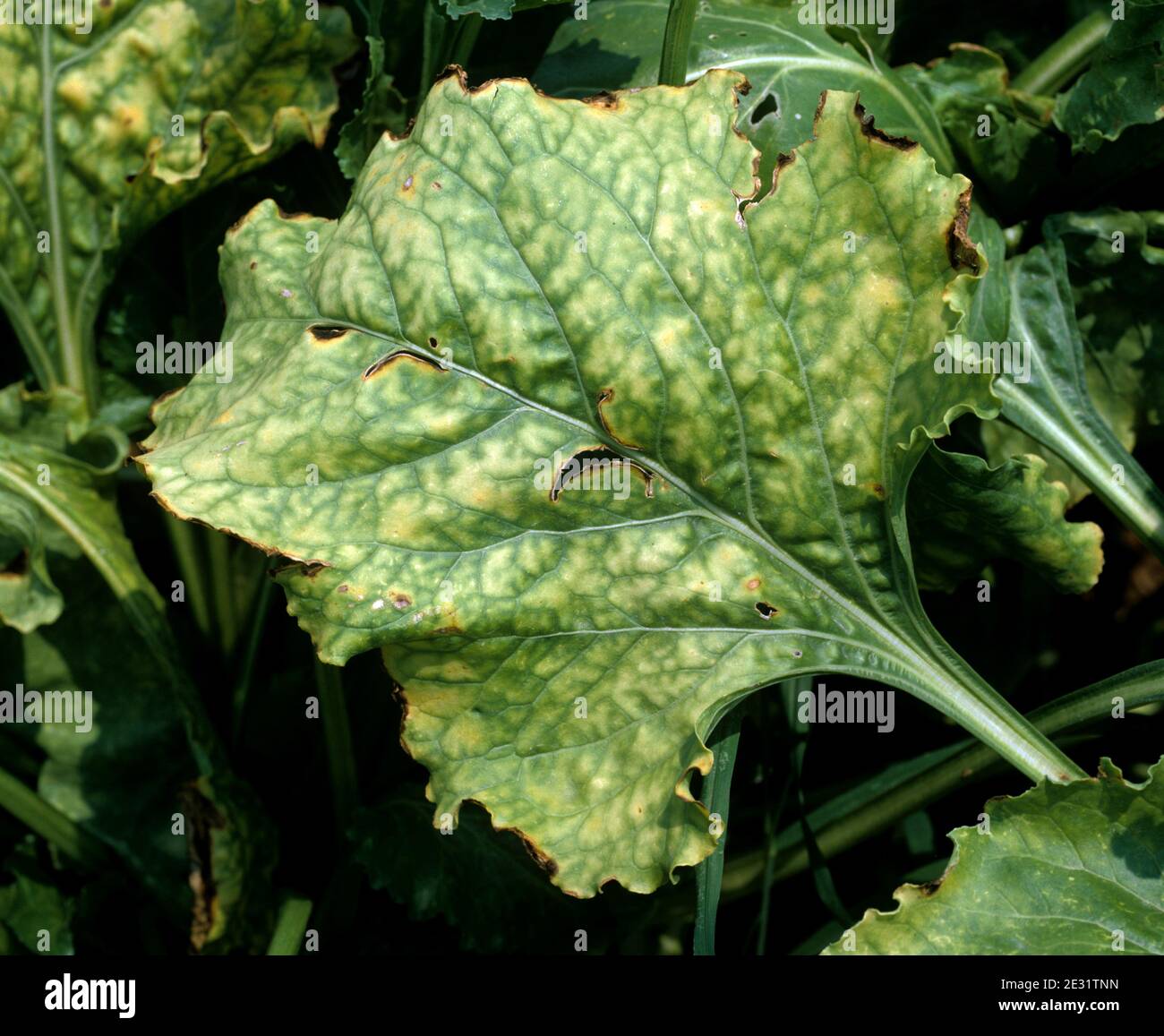 Sugar beet virus yellows (BYV) chlorosis symptoms on a sugar beet leaf in a maturing crop, Greece Stock Photohttps://www.alamy.com/image-license-details/?v=1https://www.alamy.com/sugar-beet-virus-yellows-byv-chlorosis-symptoms-on-a-sugar-beet-leaf-in-a-maturing-crop-greece-image397723809.html
Sugar beet virus yellows (BYV) chlorosis symptoms on a sugar beet leaf in a maturing crop, Greece Stock Photohttps://www.alamy.com/image-license-details/?v=1https://www.alamy.com/sugar-beet-virus-yellows-byv-chlorosis-symptoms-on-a-sugar-beet-leaf-in-a-maturing-crop-greece-image397723809.htmlRM2E31TNN–Sugar beet virus yellows (BYV) chlorosis symptoms on a sugar beet leaf in a maturing crop, Greece
 Fresh foods to strengthen the immune system to fight the Corona Virus 2019, COVID 19 Stock Photohttps://www.alamy.com/image-license-details/?v=1https://www.alamy.com/fresh-foods-to-strengthen-the-immune-system-to-fight-the-corona-virus-2019-covid-19-image353286975.html
Fresh foods to strengthen the immune system to fight the Corona Virus 2019, COVID 19 Stock Photohttps://www.alamy.com/image-license-details/?v=1https://www.alamy.com/fresh-foods-to-strengthen-the-immune-system-to-fight-the-corona-virus-2019-covid-19-image353286975.htmlRF2BENH3Y–Fresh foods to strengthen the immune system to fight the Corona Virus 2019, COVID 19
 A beet plant contaminated by yellowing. Last spring, the plant fell victim to an aphid that transmitted the yellowing virus, blocking photosynthesis. The result: leaves that lose their greenness, beets that do not grow, and a lower sugar content than usual. This unprecedented crisis is threatening the beet industry. On September 11, 2020 in Saint-Just-en-Brie, France. (Photo by Emeric Fohlen/NurPhoto) Stock Photohttps://www.alamy.com/image-license-details/?v=1https://www.alamy.com/a-beet-plant-contaminated-by-yellowing-last-spring-the-plant-fell-victim-to-an-aphid-that-transmitted-the-yellowing-virus-blocking-photosynthesis-the-result-leaves-that-lose-their-greenness-beets-that-do-not-grow-and-a-lower-sugar-content-than-usual-this-unprecedented-crisis-is-threatening-the-beet-industry-on-september-11-2020-in-saint-just-en-brie-france-photo-by-emeric-fohlennurphoto-image489269789.html
A beet plant contaminated by yellowing. Last spring, the plant fell victim to an aphid that transmitted the yellowing virus, blocking photosynthesis. The result: leaves that lose their greenness, beets that do not grow, and a lower sugar content than usual. This unprecedented crisis is threatening the beet industry. On September 11, 2020 in Saint-Just-en-Brie, France. (Photo by Emeric Fohlen/NurPhoto) Stock Photohttps://www.alamy.com/image-license-details/?v=1https://www.alamy.com/a-beet-plant-contaminated-by-yellowing-last-spring-the-plant-fell-victim-to-an-aphid-that-transmitted-the-yellowing-virus-blocking-photosynthesis-the-result-leaves-that-lose-their-greenness-beets-that-do-not-grow-and-a-lower-sugar-content-than-usual-this-unprecedented-crisis-is-threatening-the-beet-industry-on-september-11-2020-in-saint-just-en-brie-france-photo-by-emeric-fohlennurphoto-image489269789.htmlRM2KC04H1–A beet plant contaminated by yellowing. Last spring, the plant fell victim to an aphid that transmitted the yellowing virus, blocking photosynthesis. The result: leaves that lose their greenness, beets that do not grow, and a lower sugar content than usual. This unprecedented crisis is threatening the beet industry. On September 11, 2020 in Saint-Just-en-Brie, France. (Photo by Emeric Fohlen/NurPhoto)
 Tulips (Tulipa) form a genus of spring-blooming perennial herbaceous bulbiferous geophytes. The flowers are usually large, showy and brightly coloured. Stock Photohttps://www.alamy.com/image-license-details/?v=1https://www.alamy.com/tulips-tulipa-form-a-genus-of-spring-blooming-perennial-herbaceous-bulbiferous-geophytes-the-flowers-are-usually-large-showy-and-brightly-coloured-image214178063.html
Tulips (Tulipa) form a genus of spring-blooming perennial herbaceous bulbiferous geophytes. The flowers are usually large, showy and brightly coloured. Stock Photohttps://www.alamy.com/image-license-details/?v=1https://www.alamy.com/tulips-tulipa-form-a-genus-of-spring-blooming-perennial-herbaceous-bulbiferous-geophytes-the-flowers-are-usually-large-showy-and-brightly-coloured-image214178063.htmlRFPCCJ8F–Tulips (Tulipa) form a genus of spring-blooming perennial herbaceous bulbiferous geophytes. The flowers are usually large, showy and brightly coloured.
 Sugar beet virus yellows foci of infection in a sugar beet crop Stock Photohttps://www.alamy.com/image-license-details/?v=1https://www.alamy.com/sugar-beet-virus-yellows-foci-of-infection-in-a-sugar-beet-crop-image9015522.html
Sugar beet virus yellows foci of infection in a sugar beet crop Stock Photohttps://www.alamy.com/image-license-details/?v=1https://www.alamy.com/sugar-beet-virus-yellows-foci-of-infection-in-a-sugar-beet-crop-image9015522.htmlRMAPFJP3–Sugar beet virus yellows foci of infection in a sugar beet crop
 Aphid spread foci of sugar beet virus yellows throught a field of infected beet (Beta vulgaris), Cambridgeshire Stock Photohttps://www.alamy.com/image-license-details/?v=1https://www.alamy.com/aphid-spread-foci-of-sugar-beet-virus-yellows-throught-a-field-of-infected-beet-beta-vulgaris-cambridgeshire-image441442715.html
Aphid spread foci of sugar beet virus yellows throught a field of infected beet (Beta vulgaris), Cambridgeshire Stock Photohttps://www.alamy.com/image-license-details/?v=1https://www.alamy.com/aphid-spread-foci-of-sugar-beet-virus-yellows-throught-a-field-of-infected-beet-beta-vulgaris-cambridgeshire-image441442715.htmlRM2GJ5CK7–Aphid spread foci of sugar beet virus yellows throught a field of infected beet (Beta vulgaris), Cambridgeshire
 A beet plant contaminated by yellowing. Last spring, the plant fell victim to an aphid that transmitted the yellowing virus, blocking photosynthesis. The result: leaves that lose their greenness, beets that do not grow, and a lower sugar content than usual. This unprecedented crisis is threatening the beet industry. On September 11, 2020 in Saint-Just-en-Brie, France. (Photo by Emeric Fohlen/NurPhoto) Stock Photohttps://www.alamy.com/image-license-details/?v=1https://www.alamy.com/a-beet-plant-contaminated-by-yellowing-last-spring-the-plant-fell-victim-to-an-aphid-that-transmitted-the-yellowing-virus-blocking-photosynthesis-the-result-leaves-that-lose-their-greenness-beets-that-do-not-grow-and-a-lower-sugar-content-than-usual-this-unprecedented-crisis-is-threatening-the-beet-industry-on-september-11-2020-in-saint-just-en-brie-france-photo-by-emeric-fohlennurphoto-image489269796.html
A beet plant contaminated by yellowing. Last spring, the plant fell victim to an aphid that transmitted the yellowing virus, blocking photosynthesis. The result: leaves that lose their greenness, beets that do not grow, and a lower sugar content than usual. This unprecedented crisis is threatening the beet industry. On September 11, 2020 in Saint-Just-en-Brie, France. (Photo by Emeric Fohlen/NurPhoto) Stock Photohttps://www.alamy.com/image-license-details/?v=1https://www.alamy.com/a-beet-plant-contaminated-by-yellowing-last-spring-the-plant-fell-victim-to-an-aphid-that-transmitted-the-yellowing-virus-blocking-photosynthesis-the-result-leaves-that-lose-their-greenness-beets-that-do-not-grow-and-a-lower-sugar-content-than-usual-this-unprecedented-crisis-is-threatening-the-beet-industry-on-september-11-2020-in-saint-just-en-brie-france-photo-by-emeric-fohlennurphoto-image489269796.htmlRM2KC04H8–A beet plant contaminated by yellowing. Last spring, the plant fell victim to an aphid that transmitted the yellowing virus, blocking photosynthesis. The result: leaves that lose their greenness, beets that do not grow, and a lower sugar content than usual. This unprecedented crisis is threatening the beet industry. On September 11, 2020 in Saint-Just-en-Brie, France. (Photo by Emeric Fohlen/NurPhoto)
 Tulips (Tulipa) form a genus of spring-blooming perennial herbaceous bulbiferous geophytes. The flowers are usually large, showy and brightly coloured Stock Photohttps://www.alamy.com/image-license-details/?v=1https://www.alamy.com/tulips-tulipa-form-a-genus-of-spring-blooming-perennial-herbaceous-bulbiferous-geophytes-the-flowers-are-usually-large-showy-and-brightly-coloured-image214178110.html
Tulips (Tulipa) form a genus of spring-blooming perennial herbaceous bulbiferous geophytes. The flowers are usually large, showy and brightly coloured Stock Photohttps://www.alamy.com/image-license-details/?v=1https://www.alamy.com/tulips-tulipa-form-a-genus-of-spring-blooming-perennial-herbaceous-bulbiferous-geophytes-the-flowers-are-usually-large-showy-and-brightly-coloured-image214178110.htmlRFPCCJA6–Tulips (Tulipa) form a genus of spring-blooming perennial herbaceous bulbiferous geophytes. The flowers are usually large, showy and brightly coloured
 Tulips (Tulipa) form a genus of spring-blooming perennial herbaceous bulbiferous geophytes. The flowers are usually large, showy and brightly coloured. Stock Photohttps://www.alamy.com/image-license-details/?v=1https://www.alamy.com/tulips-tulipa-form-a-genus-of-spring-blooming-perennial-herbaceous-bulbiferous-geophytes-the-flowers-are-usually-large-showy-and-brightly-coloured-image214177984.html
Tulips (Tulipa) form a genus of spring-blooming perennial herbaceous bulbiferous geophytes. The flowers are usually large, showy and brightly coloured. Stock Photohttps://www.alamy.com/image-license-details/?v=1https://www.alamy.com/tulips-tulipa-form-a-genus-of-spring-blooming-perennial-herbaceous-bulbiferous-geophytes-the-flowers-are-usually-large-showy-and-brightly-coloured-image214177984.htmlRFPCCJ5M–Tulips (Tulipa) form a genus of spring-blooming perennial herbaceous bulbiferous geophytes. The flowers are usually large, showy and brightly coloured.
 A beet plant contaminated by yellowing. Last spring, the plant fell victim to an aphid that transmitted the yellowing virus, blocking photosynthesis. The result: leaves that lose their greenness, beets that do not grow, and a lower sugar content than usual. This unprecedented crisis is threatening the beet industry. On September 11, 2020 in Saint-Just-en-Brie, France. (Photo by Emeric Fohlen/NurPhoto) Stock Photohttps://www.alamy.com/image-license-details/?v=1https://www.alamy.com/a-beet-plant-contaminated-by-yellowing-last-spring-the-plant-fell-victim-to-an-aphid-that-transmitted-the-yellowing-virus-blocking-photosynthesis-the-result-leaves-that-lose-their-greenness-beets-that-do-not-grow-and-a-lower-sugar-content-than-usual-this-unprecedented-crisis-is-threatening-the-beet-industry-on-september-11-2020-in-saint-just-en-brie-france-photo-by-emeric-fohlennurphoto-image489269797.html
A beet plant contaminated by yellowing. Last spring, the plant fell victim to an aphid that transmitted the yellowing virus, blocking photosynthesis. The result: leaves that lose their greenness, beets that do not grow, and a lower sugar content than usual. This unprecedented crisis is threatening the beet industry. On September 11, 2020 in Saint-Just-en-Brie, France. (Photo by Emeric Fohlen/NurPhoto) Stock Photohttps://www.alamy.com/image-license-details/?v=1https://www.alamy.com/a-beet-plant-contaminated-by-yellowing-last-spring-the-plant-fell-victim-to-an-aphid-that-transmitted-the-yellowing-virus-blocking-photosynthesis-the-result-leaves-that-lose-their-greenness-beets-that-do-not-grow-and-a-lower-sugar-content-than-usual-this-unprecedented-crisis-is-threatening-the-beet-industry-on-september-11-2020-in-saint-just-en-brie-france-photo-by-emeric-fohlennurphoto-image489269797.htmlRM2KC04H9–A beet plant contaminated by yellowing. Last spring, the plant fell victim to an aphid that transmitted the yellowing virus, blocking photosynthesis. The result: leaves that lose their greenness, beets that do not grow, and a lower sugar content than usual. This unprecedented crisis is threatening the beet industry. On September 11, 2020 in Saint-Just-en-Brie, France. (Photo by Emeric Fohlen/NurPhoto)
 Tulips (Tulipa) form a genus of spring-blooming perennial herbaceous bulbiferous geophytes. The flowers are usually large, showy and brightly coloured. Stock Photohttps://www.alamy.com/image-license-details/?v=1https://www.alamy.com/tulips-tulipa-form-a-genus-of-spring-blooming-perennial-herbaceous-bulbiferous-geophytes-the-flowers-are-usually-large-showy-and-brightly-coloured-image214177971.html
Tulips (Tulipa) form a genus of spring-blooming perennial herbaceous bulbiferous geophytes. The flowers are usually large, showy and brightly coloured. Stock Photohttps://www.alamy.com/image-license-details/?v=1https://www.alamy.com/tulips-tulipa-form-a-genus-of-spring-blooming-perennial-herbaceous-bulbiferous-geophytes-the-flowers-are-usually-large-showy-and-brightly-coloured-image214177971.htmlRFPCCJ57–Tulips (Tulipa) form a genus of spring-blooming perennial herbaceous bulbiferous geophytes. The flowers are usually large, showy and brightly coloured.
 Tulips (Tulipa) form a genus of spring-blooming perennial herbaceous bulbiferous geophytes. The flowers are usually large, showy and brightly coloured. Stock Photohttps://www.alamy.com/image-license-details/?v=1https://www.alamy.com/tulips-tulipa-form-a-genus-of-spring-blooming-perennial-herbaceous-bulbiferous-geophytes-the-flowers-are-usually-large-showy-and-brightly-coloured-image214177998.html
Tulips (Tulipa) form a genus of spring-blooming perennial herbaceous bulbiferous geophytes. The flowers are usually large, showy and brightly coloured. Stock Photohttps://www.alamy.com/image-license-details/?v=1https://www.alamy.com/tulips-tulipa-form-a-genus-of-spring-blooming-perennial-herbaceous-bulbiferous-geophytes-the-flowers-are-usually-large-showy-and-brightly-coloured-image214177998.htmlRFPCCJ66–Tulips (Tulipa) form a genus of spring-blooming perennial herbaceous bulbiferous geophytes. The flowers are usually large, showy and brightly coloured.
 Tulips (Tulipa) form a genus of spring-blooming perennial herbaceous bulbiferous geophytes. The flowers are usually large, showy and brightly coloured Stock Photohttps://www.alamy.com/image-license-details/?v=1https://www.alamy.com/tulips-tulipa-form-a-genus-of-spring-blooming-perennial-herbaceous-bulbiferous-geophytes-the-flowers-are-usually-large-showy-and-brightly-coloured-image214335478.html
Tulips (Tulipa) form a genus of spring-blooming perennial herbaceous bulbiferous geophytes. The flowers are usually large, showy and brightly coloured Stock Photohttps://www.alamy.com/image-license-details/?v=1https://www.alamy.com/tulips-tulipa-form-a-genus-of-spring-blooming-perennial-herbaceous-bulbiferous-geophytes-the-flowers-are-usually-large-showy-and-brightly-coloured-image214335478.htmlRFPCKR2E–Tulips (Tulipa) form a genus of spring-blooming perennial herbaceous bulbiferous geophytes. The flowers are usually large, showy and brightly coloured
 Tulips (Tulipa) form a genus of spring-blooming perennial herbaceous bulbiferous geophytes. The flowers are usually large, showy and brightly coloured. Stock Photohttps://www.alamy.com/image-license-details/?v=1https://www.alamy.com/tulips-tulipa-form-a-genus-of-spring-blooming-perennial-herbaceous-bulbiferous-geophytes-the-flowers-are-usually-large-showy-and-brightly-coloured-image214177955.html
Tulips (Tulipa) form a genus of spring-blooming perennial herbaceous bulbiferous geophytes. The flowers are usually large, showy and brightly coloured. Stock Photohttps://www.alamy.com/image-license-details/?v=1https://www.alamy.com/tulips-tulipa-form-a-genus-of-spring-blooming-perennial-herbaceous-bulbiferous-geophytes-the-flowers-are-usually-large-showy-and-brightly-coloured-image214177955.htmlRFPCCJ4K–Tulips (Tulipa) form a genus of spring-blooming perennial herbaceous bulbiferous geophytes. The flowers are usually large, showy and brightly coloured.
 Tulips (Tulipa) form a genus of spring-blooming perennial herbaceous bulbiferous geophytes. The flowers are usually large, showy and brightly coloured. Stock Photohttps://www.alamy.com/image-license-details/?v=1https://www.alamy.com/tulips-tulipa-form-a-genus-of-spring-blooming-perennial-herbaceous-bulbiferous-geophytes-the-flowers-are-usually-large-showy-and-brightly-coloured-image214178012.html
Tulips (Tulipa) form a genus of spring-blooming perennial herbaceous bulbiferous geophytes. The flowers are usually large, showy and brightly coloured. Stock Photohttps://www.alamy.com/image-license-details/?v=1https://www.alamy.com/tulips-tulipa-form-a-genus-of-spring-blooming-perennial-herbaceous-bulbiferous-geophytes-the-flowers-are-usually-large-showy-and-brightly-coloured-image214178012.htmlRFPCCJ6M–Tulips (Tulipa) form a genus of spring-blooming perennial herbaceous bulbiferous geophytes. The flowers are usually large, showy and brightly coloured.
 Tulips (Tulipa) form a genus of spring-blooming perennial herbaceous bulbiferous geophytes. The flowers are usually large, showy and brightly coloured Stock Photohttps://www.alamy.com/image-license-details/?v=1https://www.alamy.com/tulips-tulipa-form-a-genus-of-spring-blooming-perennial-herbaceous-bulbiferous-geophytes-the-flowers-are-usually-large-showy-and-brightly-coloured-image214335485.html
Tulips (Tulipa) form a genus of spring-blooming perennial herbaceous bulbiferous geophytes. The flowers are usually large, showy and brightly coloured Stock Photohttps://www.alamy.com/image-license-details/?v=1https://www.alamy.com/tulips-tulipa-form-a-genus-of-spring-blooming-perennial-herbaceous-bulbiferous-geophytes-the-flowers-are-usually-large-showy-and-brightly-coloured-image214335485.htmlRFPCKR2N–Tulips (Tulipa) form a genus of spring-blooming perennial herbaceous bulbiferous geophytes. The flowers are usually large, showy and brightly coloured
 Tulips (Tulipa) form a genus of spring-blooming perennial herbaceous bulbiferous geophytes. The flowers are usually large, showy and brightly coloured. Stock Photohttps://www.alamy.com/image-license-details/?v=1https://www.alamy.com/tulips-tulipa-form-a-genus-of-spring-blooming-perennial-herbaceous-bulbiferous-geophytes-the-flowers-are-usually-large-showy-and-brightly-coloured-image214177915.html
Tulips (Tulipa) form a genus of spring-blooming perennial herbaceous bulbiferous geophytes. The flowers are usually large, showy and brightly coloured. Stock Photohttps://www.alamy.com/image-license-details/?v=1https://www.alamy.com/tulips-tulipa-form-a-genus-of-spring-blooming-perennial-herbaceous-bulbiferous-geophytes-the-flowers-are-usually-large-showy-and-brightly-coloured-image214177915.htmlRFPCCJ37–Tulips (Tulipa) form a genus of spring-blooming perennial herbaceous bulbiferous geophytes. The flowers are usually large, showy and brightly coloured.
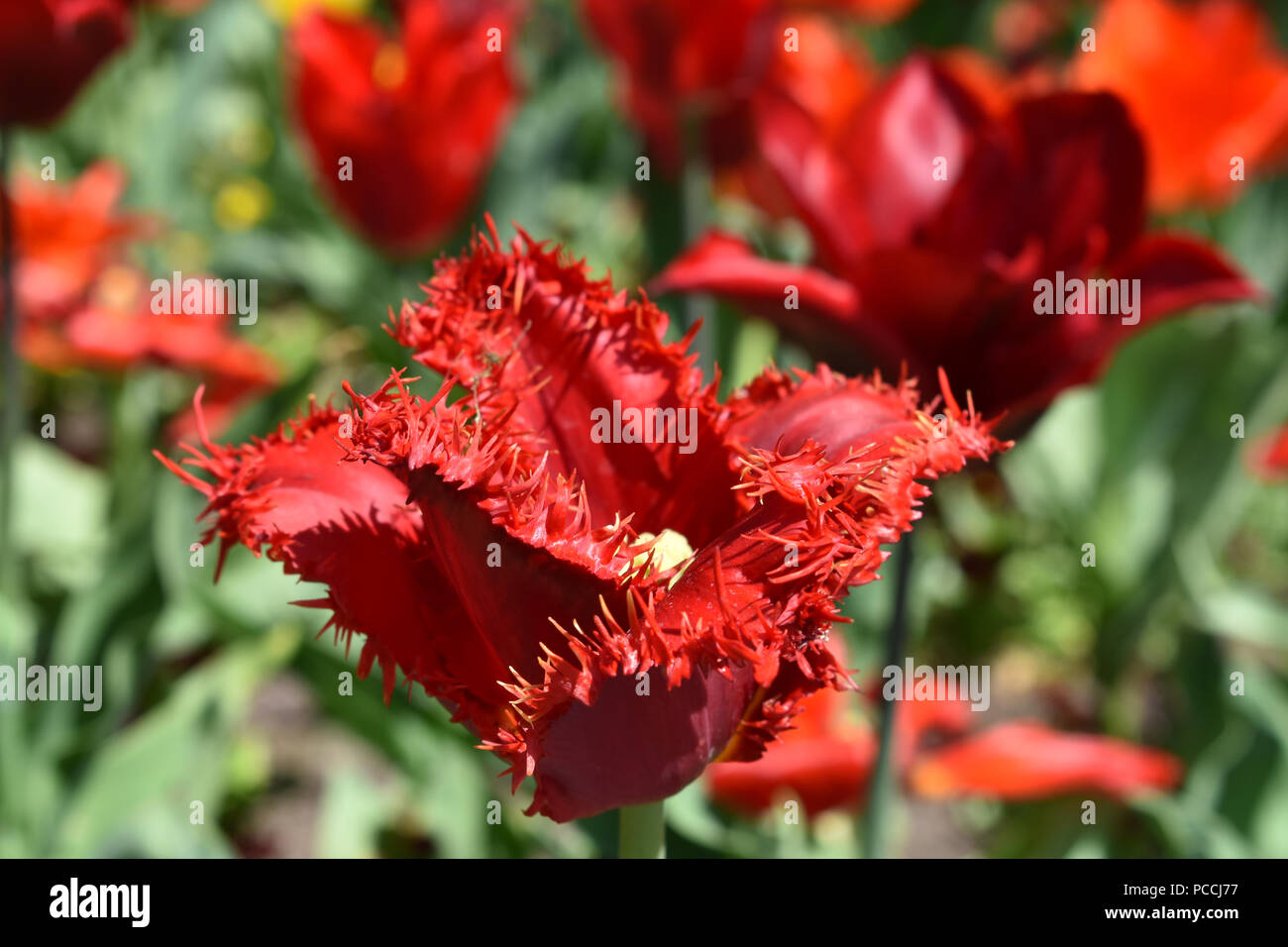 Tulips (Tulipa) form a genus of spring-blooming perennial herbaceous bulbiferous geophytes. The flowers are usually large, showy and brightly coloured. Stock Photohttps://www.alamy.com/image-license-details/?v=1https://www.alamy.com/tulips-tulipa-form-a-genus-of-spring-blooming-perennial-herbaceous-bulbiferous-geophytes-the-flowers-are-usually-large-showy-and-brightly-coloured-image214178027.html
Tulips (Tulipa) form a genus of spring-blooming perennial herbaceous bulbiferous geophytes. The flowers are usually large, showy and brightly coloured. Stock Photohttps://www.alamy.com/image-license-details/?v=1https://www.alamy.com/tulips-tulipa-form-a-genus-of-spring-blooming-perennial-herbaceous-bulbiferous-geophytes-the-flowers-are-usually-large-showy-and-brightly-coloured-image214178027.htmlRFPCCJ77–Tulips (Tulipa) form a genus of spring-blooming perennial herbaceous bulbiferous geophytes. The flowers are usually large, showy and brightly coloured.
 Tulips (Tulipa) form a genus of spring-blooming perennial herbaceous bulbiferous geophytes. The flowers are usually large, showy and brightly coloured. Stock Photohttps://www.alamy.com/image-license-details/?v=1https://www.alamy.com/tulips-tulipa-form-a-genus-of-spring-blooming-perennial-herbaceous-bulbiferous-geophytes-the-flowers-are-usually-large-showy-and-brightly-coloured-image214177941.html
Tulips (Tulipa) form a genus of spring-blooming perennial herbaceous bulbiferous geophytes. The flowers are usually large, showy and brightly coloured. Stock Photohttps://www.alamy.com/image-license-details/?v=1https://www.alamy.com/tulips-tulipa-form-a-genus-of-spring-blooming-perennial-herbaceous-bulbiferous-geophytes-the-flowers-are-usually-large-showy-and-brightly-coloured-image214177941.htmlRFPCCJ45–Tulips (Tulipa) form a genus of spring-blooming perennial herbaceous bulbiferous geophytes. The flowers are usually large, showy and brightly coloured.
 Tulips (Tulipa) form a genus of spring-blooming perennial herbaceous bulbiferous geophytes. The flowers are usually large, showy and brightly coloured. Stock Photohttps://www.alamy.com/image-license-details/?v=1https://www.alamy.com/tulips-tulipa-form-a-genus-of-spring-blooming-perennial-herbaceous-bulbiferous-geophytes-the-flowers-are-usually-large-showy-and-brightly-coloured-image214177878.html
Tulips (Tulipa) form a genus of spring-blooming perennial herbaceous bulbiferous geophytes. The flowers are usually large, showy and brightly coloured. Stock Photohttps://www.alamy.com/image-license-details/?v=1https://www.alamy.com/tulips-tulipa-form-a-genus-of-spring-blooming-perennial-herbaceous-bulbiferous-geophytes-the-flowers-are-usually-large-showy-and-brightly-coloured-image214177878.htmlRFPCCJ1X–Tulips (Tulipa) form a genus of spring-blooming perennial herbaceous bulbiferous geophytes. The flowers are usually large, showy and brightly coloured.
 Tulips (Tulipa) form a genus of spring-blooming perennial herbaceous bulbiferous geophytes. The flowers are usually large, showy and brightly coloured. Stock Photohttps://www.alamy.com/image-license-details/?v=1https://www.alamy.com/tulips-tulipa-form-a-genus-of-spring-blooming-perennial-herbaceous-bulbiferous-geophytes-the-flowers-are-usually-large-showy-and-brightly-coloured-image214177897.html
Tulips (Tulipa) form a genus of spring-blooming perennial herbaceous bulbiferous geophytes. The flowers are usually large, showy and brightly coloured. Stock Photohttps://www.alamy.com/image-license-details/?v=1https://www.alamy.com/tulips-tulipa-form-a-genus-of-spring-blooming-perennial-herbaceous-bulbiferous-geophytes-the-flowers-are-usually-large-showy-and-brightly-coloured-image214177897.htmlRFPCCJ2H–Tulips (Tulipa) form a genus of spring-blooming perennial herbaceous bulbiferous geophytes. The flowers are usually large, showy and brightly coloured.
 Tulips (Tulipa) form a genus of spring-blooming perennial herbaceous bulbiferous geophytes. The flowers are usually large, showy and brightly coloured Stock Photohttps://www.alamy.com/image-license-details/?v=1https://www.alamy.com/tulips-tulipa-form-a-genus-of-spring-blooming-perennial-herbaceous-bulbiferous-geophytes-the-flowers-are-usually-large-showy-and-brightly-coloured-image214335460.html
Tulips (Tulipa) form a genus of spring-blooming perennial herbaceous bulbiferous geophytes. The flowers are usually large, showy and brightly coloured Stock Photohttps://www.alamy.com/image-license-details/?v=1https://www.alamy.com/tulips-tulipa-form-a-genus-of-spring-blooming-perennial-herbaceous-bulbiferous-geophytes-the-flowers-are-usually-large-showy-and-brightly-coloured-image214335460.htmlRFPCKR1T–Tulips (Tulipa) form a genus of spring-blooming perennial herbaceous bulbiferous geophytes. The flowers are usually large, showy and brightly coloured